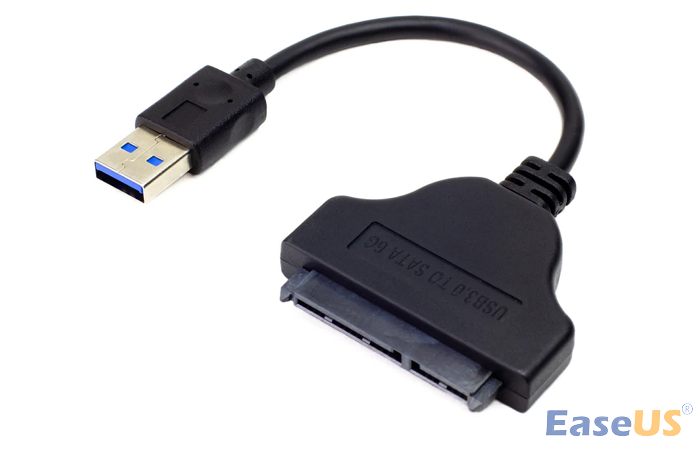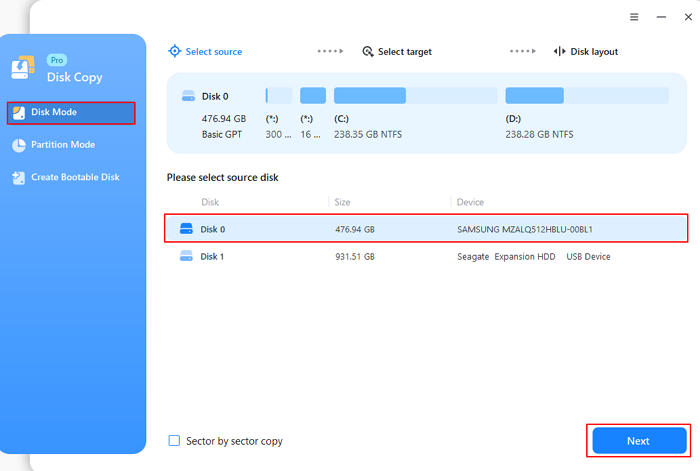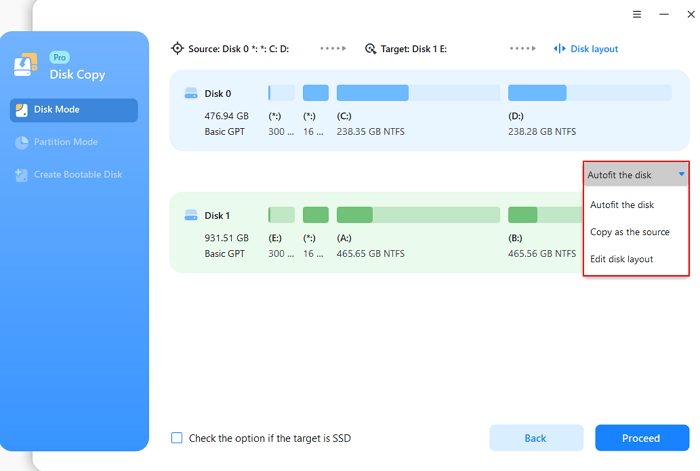Key Takeaways:
- Usually, to obtain more disk space to install programs or run Windows faster, we need to change an SSD that usually comes with limited storage.
- The noticeable benefit of cloning an SSD to another is that the whole process ensures no data loss, including operating systems, apps, settings, and personal data.
- For your information, Windows 10 and Windows 11 have no pre-installed settings to enable users to clone either an HDD or SSD. The only option is to seek out some third-party disk cloning software.
Swapping an SSD? How much SSD storage do you need?
It’s good to know the critical SSD parameters before trying to replace one, such as capacity, read/write speed, and interface types (M.2, NVMe, PCIe, etc.). In addition, SSD manufacturers also deserve your attention because their quality, reliability, and warranty vary.
Demanding a large SSD is quite commonplace due to the pre-installed HDD/SSD shows low disk space, and the computer starts lagging due to insufficient storage, especially when your C drive is full of data, which will greatly decrease your computer running speed.
When upgrading your SSD from a smaller one, how much SSD storage will suit my needs?
Generally speaking, an SSD with a capacity of 250GB or 500GB is enough for the OS, apps, and future updates. And if heavily relying on large exe files like a game player or a designer, 500GB~1TB is highly recommended.
What to prepare to successfully upgrade a small SSD
To enjoy a smooth and successful SSD cloning process, you have to make some preparations. Undoubtedly, using the best cloning software can ensure the best results.
EaseUS Disk Copy is compatible with various SSD interface types from all manufacturers. It can help you upgrade to a larger disk and clone Windows to SSD without reinstalling everything or losing data.
Moreover, to connect two SSDs, it’s essential to have a SATA-to-USB cable, which looks like in the picture.

EaseUS
At last, it is worth noting that there are different scenarios for you to change your hard drive to an SSD with a higher capacity. Check the possible solutions to clear the exact doubts.
Scenario 1: “I have a 512GB PCIe SSD to be used as a C drive with Windows 11 installed and a new empty 1TB SSD as a D drive. I want to install the operating system on the larger SSD and make it become the system and boot drive, so I want the 1TB SSD to become a C drive after cloning. How can I clone SSD C drive to larger SSD D drive, then run my Windows 11 from the bigger drive?” – from Microsoft community.
Solution: Using cloning software provided by EaseUS to help you clone your C drive to the larger D drive and change the boot drive.
Scenario 2: “I plan to transfer everything from my old SSD to my new SSD, including the OS, and keep the old ssd as a separate drive.” – from Reddit.
Solution: Use EaseUS Disk Copy, Macrium Reflect Free, or Clonezilla to help you migrate data from the old drive to a new SSD.
How to use EaseUS disk copy to clone an SSD easily
As mentioned above, if you want to install an SSD with more storage space, you need to use professional hard drive cloning software.
EaseUS Disk Copy can suit your needs in every aspect, including cloning, upgrading, transferring, and creating a WinPE bootable disk. In addition, it can also help you clone a disk with bad sectors due to its sector-by-sector clone technology and resize the disk’s layout upon completing the cloning task.
After making the necessary preparations, you can start to clone your SSD to a larger one on a Windows 11/10/8/7 PC and laptop.
Below are the testing statistics generated by our editors, during which we acquired quite a smooth, stable, and fast cloning experience with the EaseUS cloning method.
| Source SSD | Samsung | Total space: 500GB | Used space: 476.94GB |
| Target SSD | Seagate | Total space: 1TB | Available space: 931.51GB |
| Time duration | 5-10 Mins | ||
Note: The cloning speed depends on the write and read speeds of your hard drive.
Step 1. Select the source SSD
To start cloning your old SSD to another one, choose this old disk as the source disk in Disk Mode and click Next. For your case, it’s the disk showing less capacity size.

EaseUS
Step 2. Select the destination SSD
After you insert the SSD into your computer via SATA-to-USB cable or hard drive enclosure, it will be displayed as the picture shows. Choose it as your destination disk, and remember to back it up if it has data.

EaseUS
Step 3. Edit the disk layout
When you use EaseUS Disk Copy to clone your SSD, you can check the disk layout of the two SSDs.
- “Autofit the disk” will make some changes by default on the target disk layout to make it work at its best status.
- “Copy as the source” doesn’t change anything on the target disk, and the disk layout is the same as the source disk.
- “Edit disk layout” will let you manually resize/move the partition layout on the destination disk.

EaseUS
Note: A message will appear warning you that data on your target SSD will be lost. Confirm this message by clicking Continue.

EaseUS
Step 4. Start cloning SSD
After you edit your disk layout, you can click Proceed to start the cloning process.

EaseUS
Boot your PC from the cloned SSD after cloning
After the cloning process is finished, data, including the OS, on your old SSD is transferred to your new SSD. At this time, you need to remove your old SSD from your laptop or computer and install/add the new SSD to your laptop or desktop PC.
After installing the new SSD on your laptop or computer, there is only one thing left. That is, to boot your Windows from the cloned SSD. Follow the instructions below to make your computer boot Windows from SSD.
- Restart your PC, and press F2/F8/F11 or Del key to access the BIOS.
- Go to the boot tab and set the cloned SSD as the first boot choice in BIOS.
- Save all the changes and restart your PC.
All done, you should boot the computer from the cloned SSD successfully.
That is all you need to know about how to clone SSD to larger SSD on Windows 11/10/8/7. In this post, we have shown you every detail that deserves your attention when cloning/upgrading an SSD to a larger SSD drive.
Upgrading to a new or bigger SSD is a great option to enhance the performance of your Windows computer. And the easiest way is to use a professional cloning tool like EaseUS Disk Copy to help you.
EaseUS Disk Copy, with a user-friendly interface and versatile clone options, can suit your every possible need to clone a hard drive and perform other tasks. Just download it and have a go for it. It will not let you down!
FAQs on How to Clone SSD to Larger SSD
1. Can I clone SSD of different size?
Yes, you can clone hard drives of different sizes. All you need to do is find a reliable cloning tool to help you. EaseUS Disk Copy can meet your needs in this regard.
2. Can I clone a 1TB HDD to a 256GB SSD?
Yes, you can clone a larger hard drive to a smaller one. However, you have to ensure that the target drive has enough capacity to hold the data from your used space on the source drive. Or, you can clone some used partitions from your larger drive to a smaller one.
3. Why does cloning SSD take so long?
- Bad sectors. The hard drive’s bad sectors will cause the cloning process to slow down or fail.
- A large amount of data. The cloning procedure will take longer the more data there is.
- Cloning tool you use. Some cloning tools have a slow cloning speed. To solve this, you can use EaseUS Disk Copy, which has a fast cloning speed.
4. How to choose the SSD that suits your needs?
Following are five popular SSD brands and models that provide relatively high performance on a Windows PC or laptop.
| Model Name | SSD type | Capacity | Speed | Reliability | Warranty |
| Samsung 870 EVO Plus | SATA | 250/500GB, 1/2/4TB | Reads/writes up to 560/530 MB/s | High | 5 years |
| Crucial MX500 | SATA | 250/500GB, 1/2/4TB | Reads/writes up to 560/510 MB/s | High | 5 years |
| WD BLACK SN850 | M.2 | 1/2TB | Reads/writes up to 7000/5300 MB/s | High | 5 years |
| SanDisk Extreme Pro | NVMe | 250/500GB, 1/2TB | Reads/writes up to 100/90 MB/s | Medium | 5 years |
| Kingston A2000 | NVMe PCIe | 250/500GB, 1TB | Reads/writes up to 2,200/2,000 MB/s | Medium | 5 years |




